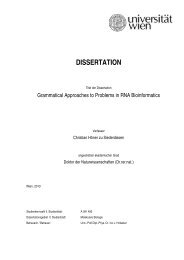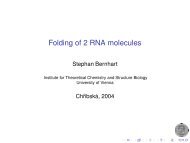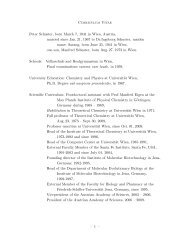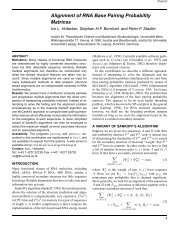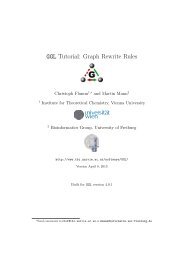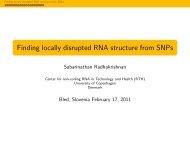A Toy Model of Chemical Reaction Networks - TBI - Universität Wien
A Toy Model of Chemical Reaction Networks - TBI - Universität Wien
A Toy Model of Chemical Reaction Networks - TBI - Universität Wien
You also want an ePaper? Increase the reach of your titles
YUMPU automatically turns print PDFs into web optimized ePapers that Google loves.
4.1. GRAPH REWRITING 37<br />
Graphical transformations can be described in terms <strong>of</strong> graphical pre- and<br />
post-conditions. It is possible to use a rule-based notation for this transformation.<br />
Such a rewrite rule is a tuple r = (g l , g r , M), where the graph g l is<br />
the left-hand side, g r is the right-hand side, and M is the set <strong>of</strong> embedding<br />
descriptions (important for the dangling ends). The implementation used in<br />
the <strong>Toy</strong> <strong>Model</strong> defines g l and g r by the elements <strong>of</strong> the graph no longer and<br />
only present after the transformation, respectively, and by a context which<br />
contains the constant element, see figs. 4.1 and 4.2.<br />
The execution <strong>of</strong> the rewrite rule is decomposed into four steps:<br />
• find an isomorphic subgraph (to g l )<br />
• remove that subgraph (keeping the dangling ends in M)<br />
• insert a new subgraph (g r )<br />
• connect it to the rest <strong>of</strong> the graph (respecting the dangling ends from<br />
M)<br />
This graph rewriting formalism is very flexible and can be used to represent<br />
chemical reactions as well as chemically impossible yet strategically<br />
interesting reactions. It may be interesting to use scaffold replacement rules<br />
for building a library in combinatorial chemistry, or to simulate deprotonation<br />
implicitly, but in reality, chemical reactions do not create or destroy<br />
atoms. A chemical reaction is the breaking, forming and changing <strong>of</strong> bonds.<br />
Thus the number and type <strong>of</strong> atoms must remain constant, which can be<br />
implemented by conservation <strong>of</strong> vertex labels. In analogy, the conservation <strong>of</strong><br />
the number <strong>of</strong> valence electrons can be imposed on rewrite rules by ensuring<br />
conservation <strong>of</strong> total bond order. Both principles stem from the fact that<br />
chemical reactions are stoichiometric [31, 113]:<br />
• conservation <strong>of</strong> vertex labels : V l = V r<br />
• conservation <strong>of</strong> total bond order : ∑ e∈E l<br />
BO(e) = ∑ e∈E r<br />
BO(e),<br />
where V i and E i are the vertices and the edges <strong>of</strong> g i , and BO(e) is the bond<br />
order <strong>of</strong> the edge e. In the example <strong>of</strong> the Diels-Alder reaction in fig. 4.2, the<br />
first condition is met because all atoms are in the constant set, the context.<br />
Counting the bond orders <strong>of</strong> g l (2+2+1+2) and g r (1+1+1+2+1+1) verifies<br />
that the second condition is also satisfied, thus this rewrite rule is chemically<br />
meaningful.<br />
This reaction representation has the advantage <strong>of</strong> representing the reaction<br />
itself also by graphs, and thus does not have the inherent limitations







